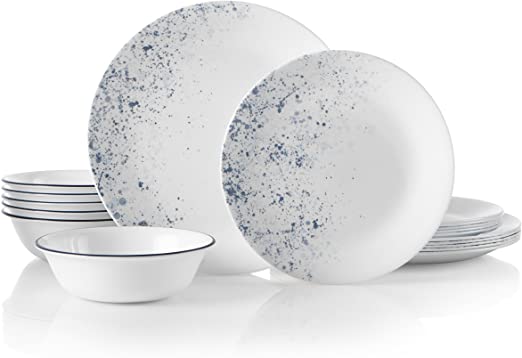Corelle dinnerware is a coveted glassware and dishware brand. They are known for their strong and durable items. Corelle is also a statement item with its hundreds of design patterns which are limited edition and have been discontinued since the change of ownership structure of the Corelle brand. Corelle glassware and dinnerware are made with a process that is different from most others and it is a valid question as to whether Corelle is microwaveable or not.
Contents
Corelle
Corelle is a top brand in durable dinnerware and is made from glass that is specially treated to make it tougher. So unlike other ceramic dinnerware Corelle is made from glass. It was introduced to the world by industrial specialised glass manufacturer Corning but now is sold by Corelle brands, a standalone company. What makes Corelle special is that it is created by taking three layers of glass and laminating them to produce a single sheet of durable glass. This provides a high degree of certainty about the durability of the glass but poses questions about how well it performs in the microwave.
How Microwaves Work
To understand why this question is reasonable, we have to look at the way a microwave works and then look at why Corelle may be a problem in this process. Microwaves are slightly complicated machines and for this discussion, it’s best we stick to the understanding that the waves created in the machine, the microwaves, do not heat food. Microwaves cause the water molecules contained in the food to vibrate at high frequency and this generates heat. This should suffice for us to understand that microwaves heat things with moisture in them. You may have noticed that some ceramic dishes also heated in the microwave along with the food. This is because ceramic dishes can over time absorb and hold moisture within them. The questions for Corelle come up because of the different layers of glass and what material is used to laminate the three layers of glass and whether that poses a moisture trapping threat.
Is Glass Microwave Safe?
The first question we have to answer is whether the glass is microwave safe and as most would rightly guess the simple answer is yes. However, it is not that simple. Not all glass is created equal and this especially applies when microwaving. While microwaves work by heating water molecules they are not bad at heating air trapped within some types of glass. Glass my have microbubbles of air in it and if these heat up and expand the glass may shatter in the microwave. Knowing that the question becomes what goes into Vitrelle, the glass Corelle is made of and is it susceptible to any of these problems?
Vitrelle
Vitrelle is a proprietary glass making process that was created by the corning glass in the 1970s. Vitrelle was created for use in television screens but later found wider use in the making of dinnerware. Vitrelle is made from a formula that uses 65 per cent recycled Vitrelle according to Corning themself. This is recycled glass from previous production runs. The remaining 35 per cent is a mixture of sand, salt, limestone, feldspar and two other materials. The proportions used in the formula are a closely guarded trade secret. Straight from the point of melting the glass is made in three layers. The glass is then cut, rounded, decorated, tested for quality and run through a kiln to produce the final product. The three layers are bonded using heat before the dinnerware is cut to shape. Then the shapes are once again bonded in a high heat process. After that, the ends are sealed using extremely high temperatures to completely seal the three layers together and provide what appears as a single layer of glass or ceramic ware. Meaning no foreign material is used in the lamination process. The Vitrelle process produces glass that has negligible air pockets if any in the glass. A sample from each production run is then put through drop tests and side-impact tests with a zero failure rate accepted. To summarise Vitrelle is made of three layers of specially formulated glass that are bonded at high heat and further treated to smooth and seal the edges.
So Is Corelle Microwaveable?
The possible problems we identified for Corelle being microwave-safe were the possibility of moisture absorption and air pockets. The process that is used in Vitrelle manufacture is, at least according to Corelle, devoid of the possibility of these two defects. Glass, in general, is water-tight and the multiple layer bonding processes and the edge sealing process used in Vitrelle manufacture mean that Corelle is not susceptible to any of the moisture-related problems. As for the air bubbles, the process developed by Corning is safe from the presence of significant air bubbles in any Vitrelle made products. Even if these were to occur in the production process, two quality control points in the manufacturing process assess dishes for any warping, bubbles or any other visible signs that the dishes are not free from air bubbles or any other form of misshaping. The process used in making Vitrelle for Corelle guards against the possibility of either air pockets or moisture absorption being a problem for any owners of Corelle dinnerware.
Conclusion
After our deep dive into the how microwaves work, the potential problems for glassware in the microwave and the processes used in the manufacture of Vitrelle for Corelle dinnerware we can safely agree that Corelle is indeed microwave safe. Corelle uses only paint and no additional metal in the manufacture and design of their plates so there is no risk of the effects of metal in the microwave.

